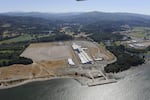A proposed methanol refinery in Kalama, Washington, would spark even more greenhouse gas emissions than previously thought, yet could replace other, harsher producers.
Those are the latest findings from the Washington Department of Ecology. The department issued its final greenhouse gas study this week on the $2 billion proposed project.
Stakeholders for and against the refinery found causes to champion in the report. Meanwhile, the report’s conclusion now starts the clock for the state to decide whether to approve the pivotal state permit.

The site at the Port of Kalama where NW Innovation Works is proposing a 90-acre methanol plant.
NW Innovation Works
If approved, it would become one of the world’s largest methanol plants. It would turn fracked natural gas from Canada into methanol that would then be shipped to China to make plastics. Proposed plans also include a 3-mile pipeline for transporting natural gas.
Many of the report’s findings first came to light in September, when the report’s first draft published. But, in the months since, ecologists took a broader view of what happens before and after the methanol is produced, and how those actions impact emissions.
Ecologists and their consultants estimate that the process of producing natural gas, cleaning it up, then sending it via pipeline would cause more greenhouse gases than first reported. Their revisions found the plant may be responsible for 1.45 million metric tons of greenhouse gas — up from 1.2 million metric tons estimated in the September report.
The bottom line is about 250,000 metric tons more per year. Comparatively, Spokane’s trash-burning waste-to-energy facility emits about 230,000 metric tons every year.
“To be aware, this increase in emissions would be things that would happen outside of Washington state,” said Neil Caudill, senior planner with Washington Ecology’s Air Quality Program. “So it’s not a direct apples-to-apples comparison, but that’s the rough scale of the emissions.”
Caudill said the second look at those emissions was spurred by the window for public comment after the draft published. The department held hearings and received 4,700 comments about the project.
They studied emissions throughout the life cycle of the facility, like fuel burned during construction and carbon releases from dredging. Findings of emissions at the site and afterward — when the methanol is shipped to Asian markets — did not significantly change in the final study.
Ecologists say worldwide demand for methanol appears to be growing regardless of whether the Kalama plant is built. OPB reported last year the company suggested to potential investors that its methanol could be sold as fuel.
With more methanol on the market, it’s likely it’ll be burned as fuel, they said.
“Emissions will go up in the world from methanol production whether this facility is built or not because there’s increasing demand,” said Stu Clarke, of the department. “But if Kalama is built, potentially (emissions) would go up less — if worldwide demand is in fact increasing and demand is being met by producers who make it in a less efficient way.”
If built, the Kalama project would send almost 1 million metric tons of carbon dioxide into the air each year. That would place it among the top 10 greenhouse gas emitters in Washington state.
Tallying the emissions the facility isn’t directly responsible for — for example: drilling for natural gas, transportation, gas leakage — the project could be associated with about 4.5 million metric tons of emissions every year.
But supporters tout its potential to emit less than other methanol makers, such as those that would make methanol from coal instead of natural gas.
The ecologists designed a model that suggested if the Kalama project isn’t built, where mostly coal-burning facilities in China could meet the demand of making methanol. That case would see more than 10 million metric tons of emissions every year, they found.
NW Innovation Works, the Chinese government-owned company proposing to build the plant, drew comparisons between old gas-powered cars and new hybrids.
“If you buy a hybrid car instead of driving an outdated older vehicle, no one will dispute that hybrid still has a carbon footprint — still has emissions,” said Kent Caputo, chief commercial officer. “What’s important is they are significantly less than the alternative you walked away from.”
Brett VandenHeuvel, executive director of Columbia Riverkeeper, called that argument a false choice when energy from wind and solar continues to grow.
“All they are doing is comparing methanol from coal to methanol from fracked gas and that’s a weak comparison,” he said. “We need to be thinking about clean fuels and electric vehicles.”
In releasing the report, state ecologists now have until late January to decide whether they would approve a permit to build on Kalama’s shore.
Still, in November, a U.S. District Court judge revoked two federal permits for the project. The judge said he did so because the permits at the time did not account for an official greenhouse gas study.
Caputo said the permits don’t directly involve the project, but the Port of Kalama, which would host the project. He said he expected the U.S. Army Corps of Engineers or the U.S. Justice Department could appeal.
“This is just what it looks like when you’re dealing with very important issues at the cutting of regulatory oversight,” Caputo said. He added that while they’d like to see a more rapid process, “we’re not concerned about more thorough analysis.”